Image To Image Translation
Image-to-image translation is the process of converting an image from one domain to another using deep learning techniques.
Papers and Code
Enabling Fast and Accurate Neutral Atom Readout through Image Denoising
Oct 29, 2025Neutral atom quantum computers hold promise for scaling up to hundreds of thousands of qubits, but their progress is constrained by slow qubit readout. Measuring qubits currently takes milliseconds-much longer than the underlying quantum gate operations-making readout the primary bottleneck in deploying quantum error correction. Because each round of QEC depends on measurement, long readout times increase cycle duration and slow down program execution. Reducing the readout duration speeds up cycles and reduces decoherence errors that accumulate while qubits idle, but it also lowers the number of collected photons, making measurements noisier and more error-prone. This tradeoff leaves neutral atom systems stuck between slow but accurate readout and fast but unreliable readout. We show that image denoising can resolve this tension. Our framework, GANDALF, uses explicit denoising using image translation to reconstruct clear signals from short, low-photon measurements, enabling reliable classification at up to 1.6x shorter readout times. Combined with lightweight classifiers and a pipelined readout design, our approach both reduces logical error rate by up to 35x and overall QEC cycle time up to 1.77x compared to state-of-the-art CNN-based readout for Cesium (Cs) Neutral Atom arrays.
TraceTrans: Translation and Spatial Tracing for Surgical Prediction
Oct 25, 2025Image-to-image translation models have achieved notable success in converting images across visual domains and are increasingly used for medical tasks such as predicting post-operative outcomes and modeling disease progression. However, most existing methods primarily aim to match the target distribution and often neglect spatial correspondences between the source and translated images. This limitation can lead to structural inconsistencies and hallucinations, undermining the reliability and interpretability of the predictions. These challenges are accentuated in clinical applications by the stringent requirement for anatomical accuracy. In this work, we present TraceTrans, a novel deformable image translation model designed for post-operative prediction that generates images aligned with the target distribution while explicitly revealing spatial correspondences with the pre-operative input. The framework employs an encoder for feature extraction and dual decoders for predicting spatial deformations and synthesizing the translated image. The predicted deformation field imposes spatial constraints on the generated output, ensuring anatomical consistency with the source. Extensive experiments on medical cosmetology and brain MRI datasets demonstrate that TraceTrans delivers accurate and interpretable post-operative predictions, highlighting its potential for reliable clinical deployment.
Alias-Free ViT: Fractional Shift Invariance via Linear Attention
Oct 26, 2025Transformers have emerged as a competitive alternative to convnets in vision tasks, yet they lack the architectural inductive bias of convnets, which may hinder their potential performance. Specifically, Vision Transformers (ViTs) are not translation-invariant and are more sensitive to minor image translations than standard convnets. Previous studies have shown, however, that convnets are also not perfectly shift-invariant, due to aliasing in downsampling and nonlinear layers. Consequently, anti-aliasing approaches have been proposed to certify convnets' translation robustness. Building on this line of work, we propose an Alias-Free ViT, which combines two main components. First, it uses alias-free downsampling and nonlinearities. Second, it uses linear cross-covariance attention that is shift-equivariant to both integer and fractional translations, enabling a shift-invariant global representation. Our model maintains competitive performance in image classification and outperforms similar-sized models in terms of robustness to adversarial translations.
Towards General Modality Translation with Contrastive and Predictive Latent Diffusion Bridge
Oct 23, 2025Recent advances in generative modeling have positioned diffusion models as state-of-the-art tools for sampling from complex data distributions. While these models have shown remarkable success across single-modality domains such as images and audio, extending their capabilities to Modality Translation (MT), translating information across different sensory modalities, remains an open challenge. Existing approaches often rely on restrictive assumptions, including shared dimensionality, Gaussian source priors, and modality-specific architectures, which limit their generality and theoretical grounding. In this work, we propose the Latent Denoising Diffusion Bridge Model (LDDBM), a general-purpose framework for modality translation based on a latent-variable extension of Denoising Diffusion Bridge Models. By operating in a shared latent space, our method learns a bridge between arbitrary modalities without requiring aligned dimensions. We introduce a contrastive alignment loss to enforce semantic consistency between paired samples and design a domain-agnostic encoder-decoder architecture tailored for noise prediction in latent space. Additionally, we propose a predictive loss to guide training toward accurate cross-domain translation and explore several training strategies to improve stability. Our approach supports arbitrary modality pairs and performs strongly on diverse MT tasks, including multi-view to 3D shape generation, image super-resolution, and multi-view scene synthesis. Comprehensive experiments and ablations validate the effectiveness of our framework, establishing a new strong baseline in general modality translation. For more information, see our project page: https://sites.google.com/view/lddbm/home.
A Multi-domain Image Translative Diffusion StyleGAN for Iris Presentation Attack Detection
Oct 16, 2025An iris biometric system can be compromised by presentation attacks (PAs) where artifacts such as artificial eyes, printed eye images, or cosmetic contact lenses are presented to the system. To counteract this, several presentation attack detection (PAD) methods have been developed. However, there is a scarcity of datasets for training and evaluating iris PAD techniques due to the implicit difficulties in constructing and imaging PAs. To address this, we introduce the Multi-domain Image Translative Diffusion StyleGAN (MID-StyleGAN), a new framework for generating synthetic ocular images that captures the PA and bonafide characteristics in multiple domains such as bonafide, printed eyes and cosmetic contact lens. MID-StyleGAN combines the strengths of diffusion models and generative adversarial networks (GANs) to produce realistic and diverse synthetic data. Our approach utilizes a multi-domain architecture that enables the translation between bonafide ocular images and different PA domains. The model employs an adaptive loss function tailored for ocular data to maintain domain consistency. Extensive experiments demonstrate that MID-StyleGAN outperforms existing methods in generating high-quality synthetic ocular images. The generated data was used to significantly enhance the performance of PAD systems, providing a scalable solution to the data scarcity problem in iris and ocular biometrics. For example, on the LivDet2020 dataset, the true detect rate at 1% false detect rate improved from 93.41% to 98.72%, showcasing the impact of the proposed method.
Time-Correlated Video Bridge Matching
Oct 14, 2025Diffusion models excel in noise-to-data generation tasks, providing a mapping from a Gaussian distribution to a more complex data distribution. However they struggle to model translations between complex distributions, limiting their effectiveness in data-to-data tasks. While Bridge Matching (BM) models address this by finding the translation between data distributions, their application to time-correlated data sequences remains unexplored. This is a critical limitation for video generation and manipulation tasks, where maintaining temporal coherence is particularly important. To address this gap, we propose Time-Correlated Video Bridge Matching (TCVBM), a framework that extends BM to time-correlated data sequences in the video domain. TCVBM explicitly models inter-sequence dependencies within the diffusion bridge, directly incorporating temporal correlations into the sampling process. We compare our approach to classical methods based on bridge matching and diffusion models for three video-related tasks: frame interpolation, image-to-video generation, and video super-resolution. TCVBM achieves superior performance across multiple quantitative metrics, demonstrating enhanced generation quality and reconstruction fidelity.
The best performance in the CARE 2025 -- Liver Task (LiSeg-Contrast): Contrast-Aware Semi-Supervised Segmentation with Domain Generalization and Test-Time Adaptation
Oct 05, 2025



Accurate liver segmentation from contrast-enhanced MRI is essential for diagnosis, treatment planning, and disease monitoring. However, it remains challenging due to limited annotated data, heterogeneous enhancement protocols, and significant domain shifts across scanners and institutions. Traditional image-to-image translation frameworks have made great progress in domain generalization, but their application is not straightforward. For example, Pix2Pix requires image registration, and cycle-GAN cannot be integrated seamlessly into segmentation pipelines. Meanwhile, these methods are originally used to deal with cross-modality scenarios, and often introduce structural distortions and suffer from unstable training, which may pose drawbacks in our single-modality scenario. To address these challenges, we propose CoSSeg-TTA, a compact segmentation framework for the GED4 (Gd-EOB-DTPA enhanced hepatobiliary phase MRI) modality built upon nnU-Netv2 and enhanced with a semi-supervised mean teacher scheme to exploit large amounts of unlabeled volumes. A domain adaptation module, incorporating a randomized histogram-based style appearance transfer function and a trainable contrast-aware network, enriches domain diversity and mitigates cross-center variability. Furthermore, a continual test-time adaptation strategy is employed to improve robustness during inference. Extensive experiments demonstrate that our framework consistently outperforms the nnU-Netv2 baseline, achieving superior Dice score and Hausdorff Distance while exhibiting strong generalization to unseen domains under low-annotation conditions.
Multi-Domain Brain Vessel Segmentation Through Feature Disentanglement
Oct 02, 2025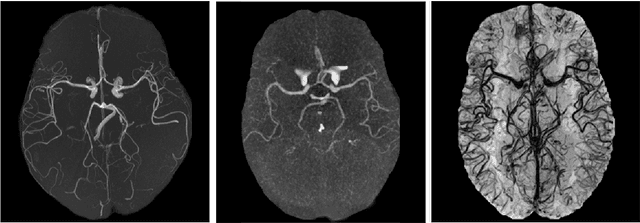


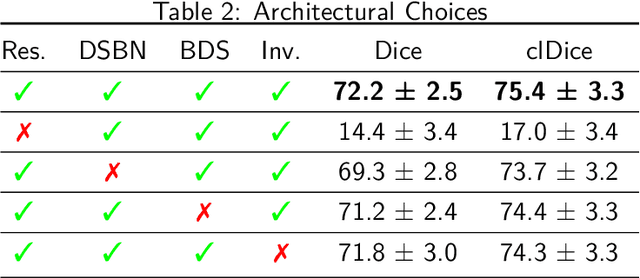
The intricate morphology of brain vessels poses significant challenges for automatic segmentation models, which usually focus on a single imaging modality. However, accurately treating brain-related conditions requires a comprehensive understanding of the cerebrovascular tree, regardless of the specific acquisition procedure. Our framework effectively segments brain arteries and veins in various datasets through image-to-image translation while avoiding domain-specific model design and data harmonization between the source and the target domain. This is accomplished by employing disentanglement techniques to independently manipulate different image properties, allowing them to move from one domain to another in a label-preserving manner. Specifically, we focus on manipulating vessel appearances during adaptation while preserving spatial information, such as shapes and locations, which are crucial for correct segmentation. Our evaluation effectively bridges large and varied domain gaps across medical centers, image modalities, and vessel types. Additionally, we conduct ablation studies on the optimal number of required annotations and other architectural choices. The results highlight our framework's robustness and versatility, demonstrating the potential of domain adaptation methodologies to perform cerebrovascular image segmentation in multiple scenarios accurately. Our code is available at https://github.com/i-vesseg/MultiVesSeg.
* 19 pages, 7 figures, 3 tables. Joint first authors: Francesco Galati and Daniele Falcetta. Accepted for publication at the Journal of Machine Learning for Biomedical Imaging (MELBA) https://melba-journal.org/2025:021. Code available at https://github.com/i-vesseg/MultiVesSeg
Clarification as Supervision: Reinforcement Learning for Vision-Language Interfaces
Sep 30, 2025



Recent text-only models demonstrate remarkable mathematical reasoning capabilities. Extending these to visual domains requires vision-language models to translate images into text descriptions. However, current models, trained to produce captions for human readers, often omit the precise details that reasoning systems require. This creates an interface mismatch: reasoners often fail not due to reasoning limitations but because they lack access to critical visual information. We propose Adaptive-Clarification Reinforcement Learning (AC-RL), which teaches vision models what information reasoners need through interaction. Our key insight is that clarification requests during training reveal information gaps; by penalizing success that requires clarification, we create pressure for comprehensive initial captions that enable the reasoner to solve the problem in a single pass. AC-RL improves average accuracy by 4.4 points over pretrained baselines across seven visual mathematical reasoning benchmarks, and analysis shows it would cut clarification requests by up to 39% if those were allowed. By treating clarification as a form of implicit supervision, AC-RL demonstrates that vision-language interfaces can be effectively learned through interaction alone, without requiring explicit annotations.
Bidirectional Mammogram View Translation with Column-Aware and Implicit 3D Conditional Diffusion
Oct 06, 2025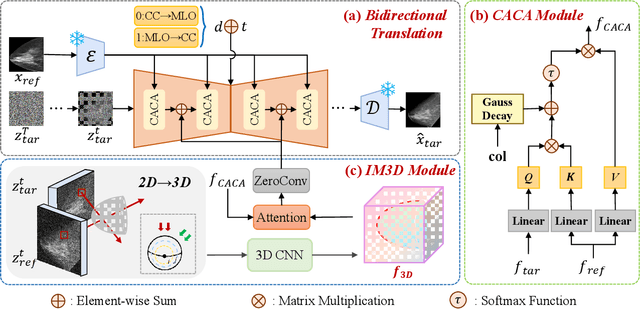
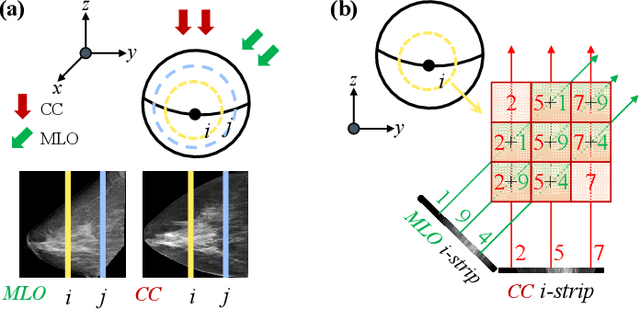
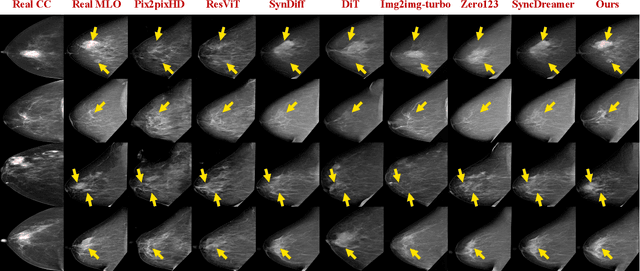
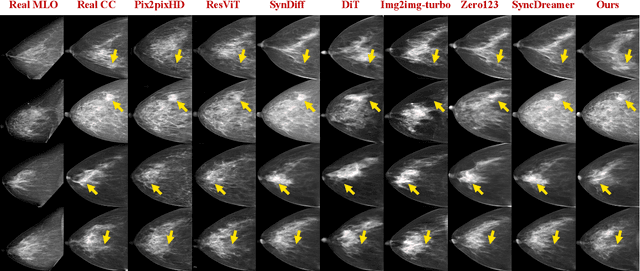
Dual-view mammography, including craniocaudal (CC) and mediolateral oblique (MLO) projections, offers complementary anatomical views crucial for breast cancer diagnosis. However, in real-world clinical workflows, one view may be missing, corrupted, or degraded due to acquisition errors or compression artifacts, limiting the effectiveness of downstream analysis. View-to-view translation can help recover missing views and improve lesion alignment. Unlike natural images, this task in mammography is highly challenging due to large non-rigid deformations and severe tissue overlap in X-ray projections, which obscure pixel-level correspondences. In this paper, we propose Column-Aware and Implicit 3D Diffusion (CA3D-Diff), a novel bidirectional mammogram view translation framework based on conditional diffusion model. To address cross-view structural misalignment, we first design a column-aware cross-attention mechanism that leverages the geometric property that anatomically corresponding regions tend to lie in similar column positions across views. A Gaussian-decayed bias is applied to emphasize local column-wise correlations while suppressing distant mismatches. Furthermore, we introduce an implicit 3D structure reconstruction module that back-projects noisy 2D latents into a coarse 3D feature volume based on breast-view projection geometry. The reconstructed 3D structure is refined and injected into the denoising UNet to guide cross-view generation with enhanced anatomical awareness. Extensive experiments demonstrate that CA3D-Diff achieves superior performance in bidirectional tasks, outperforming state-of-the-art methods in visual fidelity and structural consistency. Furthermore, the synthesized views effectively improve single-view malignancy classification in screening settings, demonstrating the practical value of our method in real-world diagnostics.
 Add to Chrome
Add to Chrome Add to Firefox
Add to Firefox Add to Edge
Add to Edge